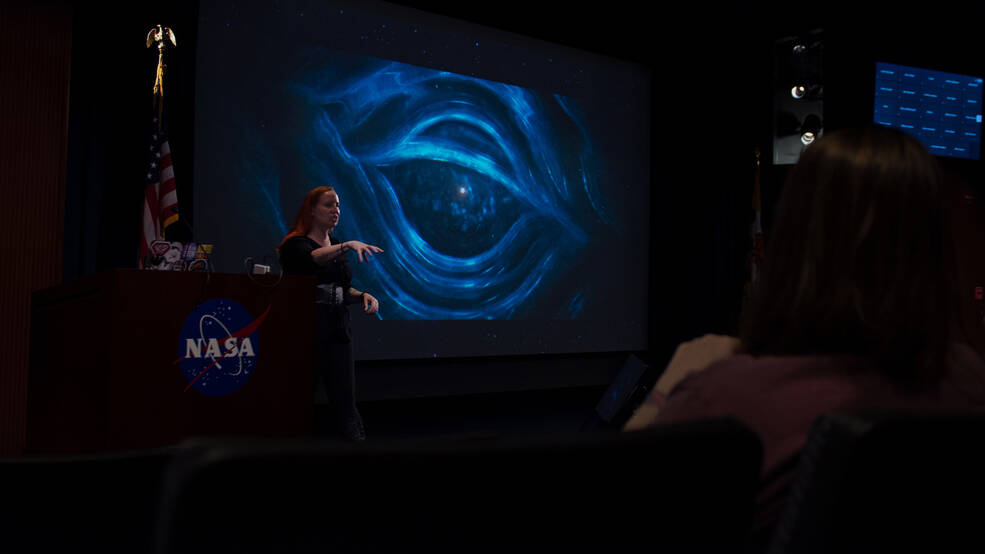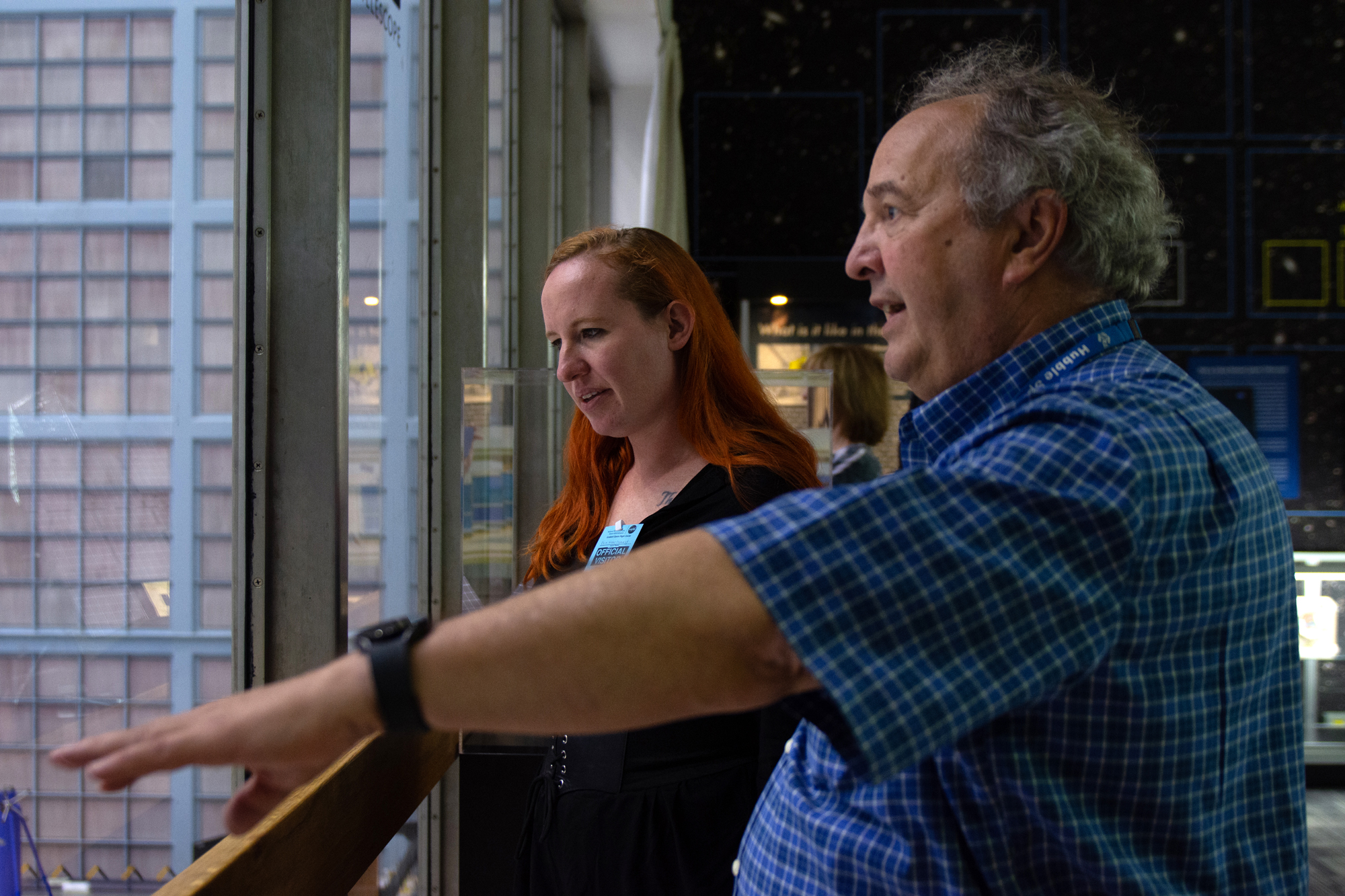On Aug. 1, Star Trek science adviser Dr. Erin Macdonald visited NASA’s Goddard Space Flight Center in Greenbelt, Maryland, to discuss how science informs Star Trek, and how Star Trek inspires science and exploration.
“Can you science that, please?”
That request will go to Dr. Erin Macdonald, along with a plotline to an upcoming “Star Trek” episode. Star Trek takes place in the Milky Way, “not a galaxy far, far away,” Macdonald said. That means Star Trek (mostly) adheres to the known laws of physics.
Macdonald – whose own Ph.D. is in gravitational astrophysics – has served as Star Trek’s science adviser since 2019, ensuring the venerable science fiction franchise gets its physics right.
On Aug. 1, she visited NASA’s Goddard Space Flight Center in Greenbelt, Maryland, to discuss how science informs Star Trek, and how Star Trek inspires science and exploration.
“There is so much renown and history at NASA Goddard, it was a wonderful opportunity to speak at this venue and to the folks who work there,” Macdonald said. “I love being able to share science fiction with a more science-oriented audience and help them see how a scientist approaches narrative storytelling.”

But how do the laws of physics apply in a sci-fi show known for its warp drives and phasers and transporters? “The way I kind of advertise my science advising is that I do a ‘yes, and’ approach,” Macdonald said. It’s important to find ways to integrate actual science when it’s appropriate “and being able to bend the rules and say, ‘Let’s just not explain it,’ when we can,” she said. “The main rule for me is to make sure nothing is said in the show that is explicitly wrong.”
NASA’s Goddard Space Flight Center
Download this video from images.nasa.gov
Dr. Ken Carpenter, Hubble Space Telescope operations project scientist, arranged for Macdonald’s visit and presentation. A noted Star Trek fan himself, Carpenter and Macdonald have been friends and colleagues-in-STEAM-activities since their first joint appearance at the 2017 StarFest Convention in Denver.
“Star Trek and NASA have had a strong connection for many years, with the former being inspired to write stories of the future by current-day NASA activities, and the latter inspired to do great things now by the stories we’ve all viewed,” Carpenter said. “Both have benefited greatly from this continuous interaction. Dr. Macdonald was the obvious choice to join the series of Trek luminaries who have visited Goddard over the years and explored this connection.”
Before the lecture, Carpenter gave Macdonald a brief tour of Goddard, which included Hubble’s operations control center, as well as the Integration and Test Complex where large portions of Hubble and the Webb telescope were tested and assembled – and where the Roman Space Telescope is now under construction.
“It was thrilling to see the Nancy Grace Roman Telescope in its early stages of development,” Macdonald said. “Additionally, I was honored to have my parents with me so they could see the work being done. They worked very hard to make sure we learned all about Hubble through the ’90s as images were released, so to see its continuing work and the future generations of these telescopes, and to share that with them, was very special.”
NASA and Star Trek have been interlinked for many decades. The first orbiter in the Space Shuttle Program debuted in 1976 with the name “Enterprise,” after the fictitious starship from the television show. NASA’s effort to recruit more Black astronaut candidates in the 1970s received help from actor Nichelle Nichols. She was one of the first Black actors to play a major part on an American primetime series with her portrayal of Lt. Uhura on Star Trek.
Macdonald’s lecture, presented under the auspices of Goddard’s Engineering Colloquium Series, marks the latest in a long tradition of Star Trek guests to visit the center. The first was actor Leonard Nimoy – “Mr. Spock” – who toured in 1967, mere months after Star Trek first hit the airwaves. Since then, Goddard has hosted actors James Doohan, Jeri Ryan, Connor Trinneer, George Takei, Nichelle Nichols, and Robert Picardo, as well as Trek technical advisers and graphic artists Rick Sternbach, Mike and Denise Okuda, and André Bormanis, and fellow scientist and STEAM advocate Dr. Mohamed Noor (who is also an occasional Star Trek science adviser alongside Macdonald).
“I’m honored to play a small role in continuing that relationship and hope to do so for many years in the future!” Macdonald said. “Where I have had a great experience is my continued relationship with peers who work at NASA and other organizations, who reach out to tell me about a new, interesting discovery, or even more, a new ‘unknown’ that has been uncovered. Here we can find ways to integrate those into the stories going forward.”
Related Links
- “Sci-Fi Creators Meld Art, Science in Visit to NASA’s Goddard Space Flight Center” (July 13, 2018)
- “Science-Fiction’s Most Famous Comm. Officer Visits Goddard” (March 2, 2012)
- “Star Trek’s George Takei Beams Down to Goddard” (June 5, 2008)
- “Engineer of the Future”: Star Trek’s “Scotty,” James Doohan, Presents at NASA Goddard (March 2, 1992)
By Rob Garner; additional reporting by Ananya Udaygiri
NASA’s Goddard Space Flight Center, Greenbelt, Md.
























